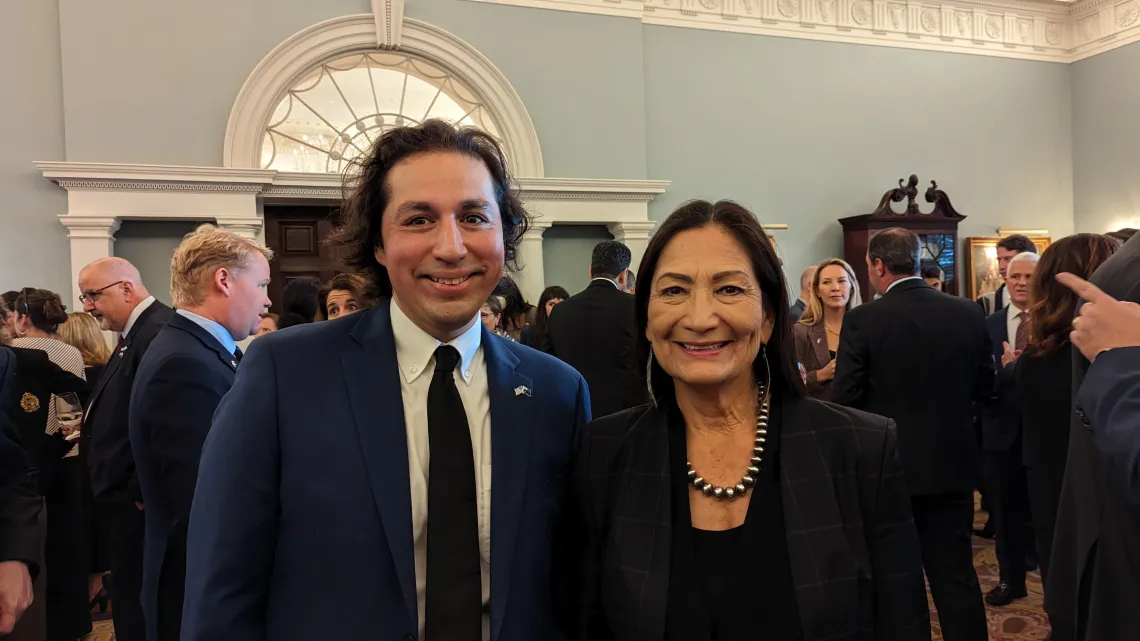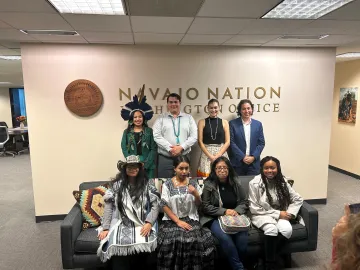Fulbright Brilliance

Vince Redhouse and U.S. Secretary of the Interior Deb Haaland at a luncheon honoring Australian Prime Minister Anthony Albanese.
Vince Redhouse
After World War II, visionaries saw an opportunity to improve relationships and understanding among countries. Leading this effort was James William Fulbright, a senator from Arkansas who was well-known for international relations. As a result, a program bearing his name — the Fulbright — adopted the mission of building mutual understanding between nations.
Now, the program dispatches approximately 9,000 students, teachers, scholars, artists and professionals around the world each year, where they pursue graduate studies, research or teaching. The Fulbright is administered by the U.S. Department of State’s Bureau of Educational and Cultural Affairs and jointly funded by the U.S. and host governments. It’s a distinguished club whose past participants include 62 Nobel Prize recipients, 90 Pulitzer Prize winners, and more than 42 current or former heads of government.
This venerable roster also includes more than a few Wildcats. In fact, the University of Arizona has an excellent track record of supporting graduating seniors, alumni, graduate students, faculty and staff in their pursuit of Fulbright opportunities. Last year, a record 17 U of A faculty and staff became Fulbright Scholars. And over the past few decades more than 240 graduating seniors, alumni, and graduate students have won U.S. Student Program Fulbright awards.
Meet an SBS scholar among this excellent group of U.S. Student Fulbright Program awardees.
Advocating for Indigenous Peoples Sovereignty
Sometimes, the best perspective on where you’re going comes from where you’ve been. Consider Vince Redhouse ’15 ’21, a Wildcat and a member of the Navajo Nation. In 2015, he traveled to Australia as a Fulbright scholarship recipient, where he studied political reconciliation between that nation’s Aboriginal people and the government that colonized them.
He came away with the conclusion that true political reconciliation between any Indigenous people and their settler colonial government requires starting from scratch: returning their autonomy and land and letting them decide whether an accord with the government is worthwhile.

Vince Redhouse (R) and international Indigenous youth at the Navajo Nation Washington Office in D.C. Redhouse worked with the State Department to help bring youth to the White House Tribal Youth Forum and then coordinated a visit to the office.
Vince Redhouse
Redhouse also left Australia convinced that he could best help Indigenous people by becoming a lawyer. Today, he works for a top tribal-focused law firm.
It was while he was studying philosophy, politics, economics and law in the College of Social and Behavioral Sciences as an undergrad that advisers in the W.A. Franke Honors College suggested he apply for a Fulbright.
At the time, he says, he didn’t even know what the award was. “But they really helped me identify the type of project that would make sense for me and where it would make sense for me to do it. Having those relationships was absolutely crucial.”
His project, pursued at Australian National University, focused on political reconciliation between Aboriginal peoples and Australia. Aboriginal people — Australia’s first inhabitants — have dwelled on that continent for 65,000 years. But, like North American Indigenous tribes, they were driven from their homelands and treated with hostility by white settlers.
When the British began colonizing Australia in 1788, they brought with them European diseases that raged through the Aboriginal populations. An estimated 20,000 Indigenous people also died in violent clashes with the colonizers. Similar to practices in the United States, many Aboriginal children throughout the 20th century were removed from their homes and sent to grim institutions in attempts to exorcise their cultural heritage. Many were also punished for speaking their native languages.
And discrimination continues today; in 2023, Australian voters soundly defeated a national referendum to include recognition of Aboriginal people in the national constitution and to require that their needs carry weight in parliamentary debate.
The issues, concerns and history of violence struck home for Redhouse, who was invited to political events and met Australian Parliament members and staff working on Indigenous issues.
"I was doing research and talking to those staffers — and just listening to the needs of Indigenous peoples out there and knowing the needs of Indigenous people” in America, he says. “To-ward the end of my Fulbright, I realized that I would be a much more useful advocate for Indigenous peoples if I had legal training.”
He returned to the U of A, earned a law degree in 2021 and now practices in Washington, D.C., with Hobbs, Straus, Dean & Walker LLP, a law firm devoted to advancing and defending tribal rights.
'You need to put Indigenous peoples in a position where they can effectively say ‘no’ to reconciling with you. And if you put them in that position, and they nonetheless decide to submit to your authority, then that’s when you can claim you have moral authority — that’s when you can say things are truly reconciled.’
He also has pondered the insights he gained overseas and continues to feel that true political reconciliation between Indigenous peoples and settler colonial states is contingent on acknowledging the right and the ability of Indigenous peoples to decide for themselves how they want to be governed.
For Redhouse, the moral authority to govern can only be earned by returning the lands and full autonomy to the people from whom they were taken, including the choice of how to move forward. Anything less, he says, is the same kind of coercion Indigenous peoples have experienced historically.
"You need to put Indigenous peoples in a position where they can effectively say ‘no’ to reconciling with you. And if you put them in that position, and they nonetheless decide to submit to your authority, then that’s when you can claim you have moral authority — that’s when you can say things are truly reconciled. It’s very hard to put it into practice, but I think the exercise itself is something to strive toward.”
In the meantime, Redhouse is leveraging his award to create a better future for Indigenous peoples. He also has lobbied for a Fulbright exchange program between the U of A and a sister institution in Australia and has become a Fulbright Alumni Ambassador, traveling to conferences, colleges, and universities where he encourages Native American students to apply for the scholarship like he did.
"There’s the need to create a new generation of Indigenous leaders that have the opportunity to lead on a global scale on global issues,” he says. “They can learn from each other about what their respective nations are doing to advance the rights and interests of Indigenous people.”
##
This content is excerpted from "Fulbright Brilliance," originally published Fall 2024.

